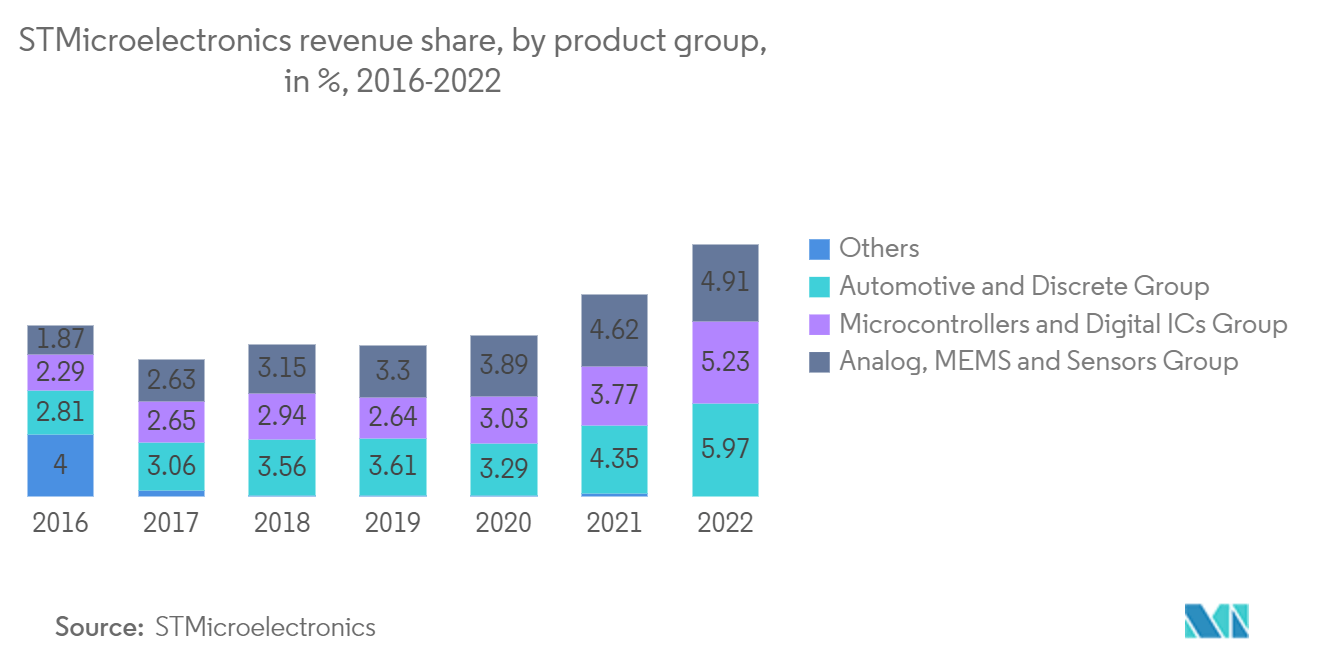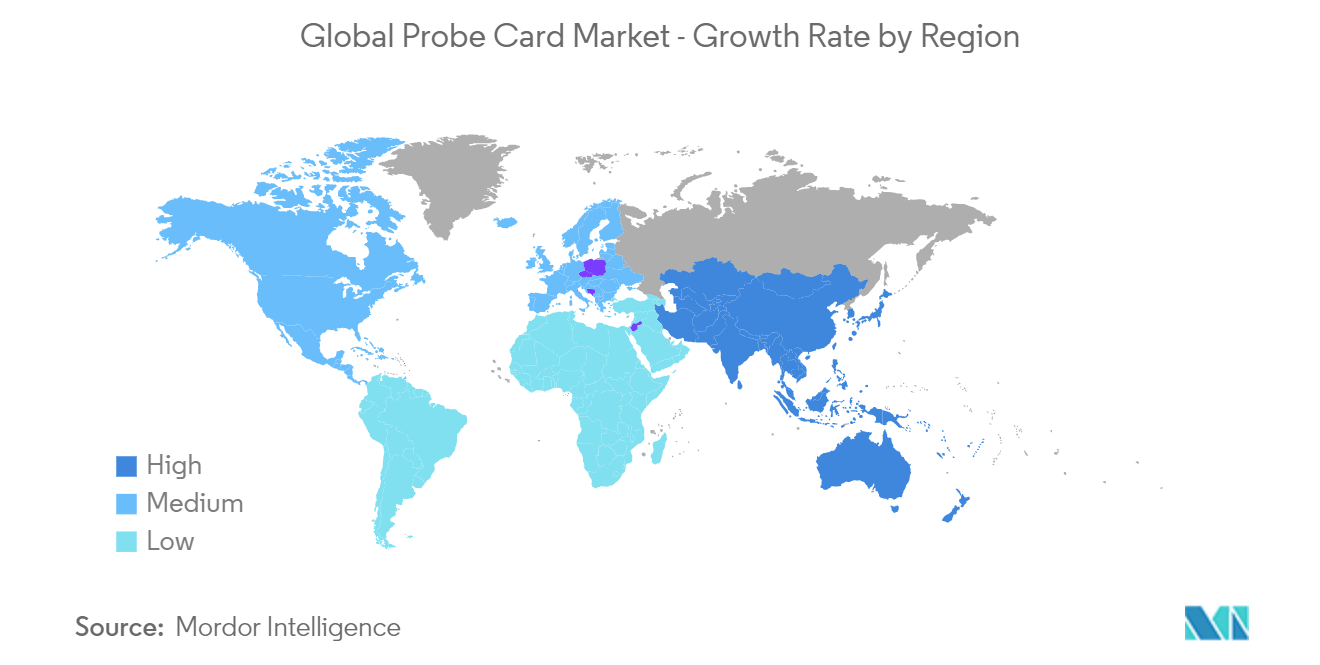Market Trends of Probe Card Industry
The MEMS Segment is Expected to Hold a Major Market Share
- MEMS technology provides a way to produce probes that contact the I/Os and power connections on ICs at micron-level perfection. Due to their accuracy, MEMS probes are suitable for supporting the advanced packaging and advanced semiconductor process nodes' fine-pitch and high-pin count requirements. However, not all MEMS probes are created equal. MEMS probe cards are at the forefront of these developments, addressing issues with advanced 2.5/3D packages, the wide temperature ranges needed to test ICs for the automotive industry, the emerging requirements for high bandwidth and efficient signal integrity in RF applications, and lowering the cost to test thousands of DRAM memory devices in a single touchdown.
- Further, probe cards are used as the main interface for signal transmission between the dies under test (DUT) and the automatic test equipment (ATE), determining if the DUT passes or fails during wafer-level IC testing. Numerous MEMS probe cards have been produced recently, some of which have been marketed due to their significant advantages over traditional probe cards. Due to its constraints, the standard probe card, which consists of an epoxy ring manually fitted with dozens to hundreds of cantilever needles, cannot be modified for next-generation IC testing. Such developments are expected to drive the study market.
- To cater to the rise in demand from customers for the MEMS probe card segment, various firms are launching new and advanced products. For example, FeinMetall Gmbh provides M-Probe probe cards, which are characterized by MEMS contact elements and are particularly suitable for fine-pitch full array applications in wafer tests. With MProbe, very fine pitches with a full array of 50 m can be realized. MProbe is based on the probe concepts of ViProbe and serves high-temperature applications almost to the same extent. The innovative free beam placement process, in combination with the round beam cross-section, offers efficient maintainability and thus reduces downtime to a minimum.
- Further, in June 2022, STAR Technologies Inc., a significant player in semiconductor test probe cards, announced a joint collaboration with one of the top foundries in the world for the successful creation of fine-pitch MEMS pre-bump probe cards for pre-bumped wafer test and reliability qualification. Further lowering the cost of pre-bumped wafer sort are these probe cards, which have probe heads manufactured on the same PCBs and space transformers as bumped test probe cards. This technique allows for a quicker transition from early-stage process technology yield ramp to high-volume manufacturing to meet the expanding worldwide chip demand in the semiconductor industry.
- Developers of MEMS probe cards must consider temperature effects as part of their MEMS design or risk several costly design-and-fabrication cycles to resolve material problems used in manufacturing. The product is typically implemented under high-pressure and high-temperature conditions. Advanced approaches utilize a thin-film deposition technique, and a cavity for MEMS is realized via sacrificial etch through access holes at the thin-film cap.

The Asia Pacific Region is Expected to Witness a High Market Growth
- Due to the presence of prominent semiconductor manufacturers, significant suppliers of semiconductor materials, high-end equipment, and specialized semiconductors, primarily in Japan, the Asia-Pacific region is anticipated to dominate the probe card market throughout the forecast period. Another factor driving the probe card market is South Korea's competitive advantage in the global high-bandwidth memory (HBM) and dynamic random-access memory (DRAM) markets. The market for probe cards is also being driven by incorporating semiconductors into automotive electronics for safety-related purposes, automation, electrification, and security.
- Further, there is an increasing sale of EVs in Asian countries, which has made companies develop IGBT semiconductors that support EV applications. For instance, in July 2021, ROHM produced hybrid IGBTs with integrated 650V SiC Schottky barrier diodes in the RGWxx65C series (RGW60TS65CHR, RGW80TS65CHR, and RGW00TS65CHR). They're intended for high-power applications in automotive and industrial applications like solar power conditioners, onboard chargers, and DC/DC converters in electric and electrified cars (xEV). In the IGBT's feedback block, the RGWxx65C series uses ROHM's low-loss SiC Schottky barrier diodes as freewheeling diodes with nearly little recovery energy and, consequently, negligible diode switching loss.
- An additional factor supporting the market for probe cards is the growing adoption of semiconductors due to new technologies like autonomous driving, artificial intelligence (AI), 5G, and the Internet of Things. To keep their competitive edge in the industry, top competitors are also focused on a variety of marketing methods like mergers and acquisitions and collaborations. To broaden its sales footprint and become more competitive in the global market, Nidec Corporation, for instance, purchased SV Probe Pte. Ltd.
- Moreover, DRAM is a high-volume commodity memory semi-component that is commonly used in smartphones, tablets, PCs, and servers, among others. Historically, DRAM memory technology went through die shrinks, and with the release of the advanced memory module, the x/y memory cell pattern on the silicon wafer is getting significantly smaller. This is also increasing the cost of manufacturing the next generation of DRAMs due to the rising requirement for precision manufacturing. Some of the major players in the market are Samsung, SK Hynix, and Micron.
- Samsung is reinforcing its dominance in the DRAM market. During the second quarter of 2021, the company registered a 43.6% share of the global DRAM market. The company has been introducing new versions of DRAMs for various end-users. For instance, in November 2021, the company announced the development of a 14-nanometer-based 16-gigabit LPDDR5X (Low Power Double Data Rate 5X DRAM) for applications in artificial intelligence, 5G, and the metaverse.
- In May 2022, Apple selected a new South Korean component supplier to provide them with sockets and probe cards for semiconductor testing. In contrast to its previous reliance on Taiwan and China, Apple is gradually moving its socket and probe card supplies to South Korea.

